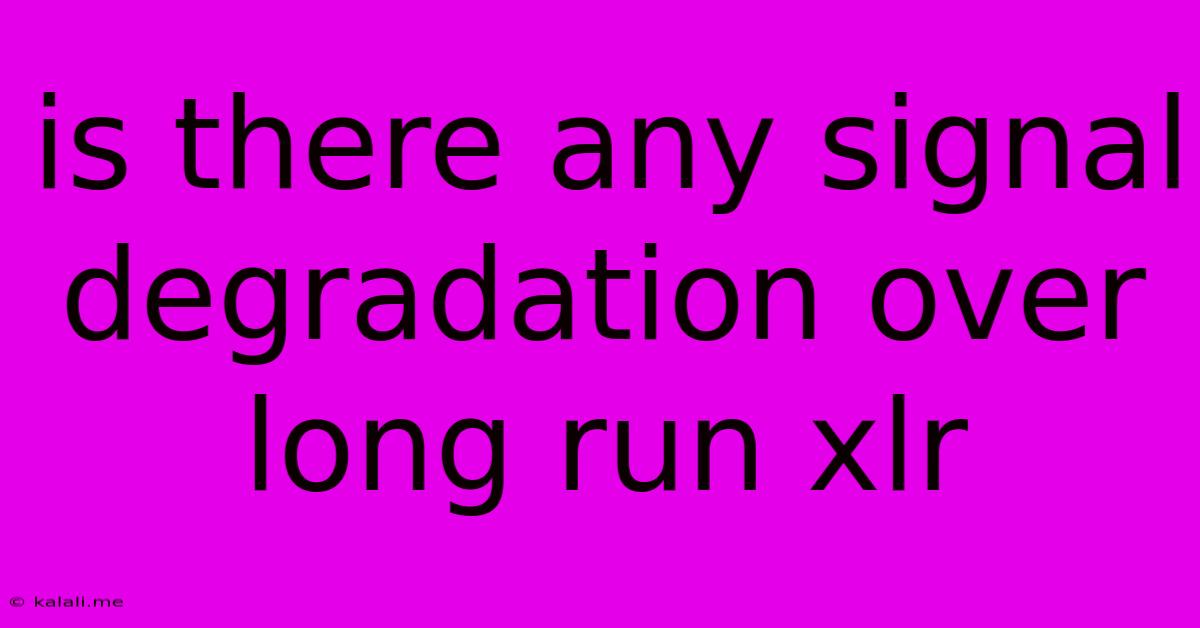Is There Any Signal Degradation Over Long Run Xlr
Kalali
Jun 01, 2025 · 3 min read

Table of Contents
Is There Signal Degradation Over Long Runs of XLR Cable?
Understanding XLR Cable and Signal Degradation: XLR connectors are the industry standard for professional audio applications, known for their robust construction and balanced signal transmission. However, even with their superior design, signal degradation over long cable runs is a real concern. This article explores the factors contributing to this degradation and offers solutions to mitigate its effects. Understanding this is key to maintaining high-fidelity audio in any professional setup, from live sound reinforcement to recording studios.
Factors Contributing to Signal Degradation:
Several factors influence signal degradation in long XLR cable runs:
-
Capacitance: XLR cables, like any cable, possess capacitance. This means they store electrical charge, and over long distances, this capacitance can accumulate, leading to a high-frequency roll-off. This manifests as a loss of high-frequency detail and a "muddy" or less clear sound. The longer the cable, the greater the capacitance and thus the more significant the degradation.
-
Resistance: The resistance of the cable conductors also plays a crucial role. Longer cables have higher resistance, leading to signal attenuation (loss of signal strength). This attenuation is more noticeable at higher frequencies and can result in a weak or quiet signal at the receiving end. Higher-gauge cables (thicker conductors) offer lower resistance and thus better performance over long distances.
-
Inductance: The inherent inductance of the cable can also contribute to signal loss, especially at higher frequencies. Inductance creates an impedance that opposes the flow of current, leading to signal attenuation. While not as significant as capacitance and resistance, it still plays a role in overall signal degradation.
-
Electromagnetic Interference (EMI) and Radio Frequency Interference (RFI): Long cable runs are more susceptible to picking up unwanted noise from external sources like power lines, fluorescent lights, and radio waves. Balanced XLR cables help to reject this noise, but it's not completely eliminated, particularly in noisy environments. Shielding quality plays a significant role in minimizing EMI and RFI.
-
Cable Quality: The quality of the XLR cable itself greatly influences its performance over long distances. Cheap cables tend to have lower-quality materials, thinner conductors, and less effective shielding, leading to increased signal degradation.
Mitigating Signal Degradation:
Several strategies can help minimize signal degradation over long XLR cable runs:
-
Use Higher-Gauge Cables: Choosing cables with thicker conductors (lower gauge number) reduces resistance and improves signal transmission.
-
Employ Active Direct Boxes (DI Boxes): DI boxes can boost the signal strength and provide impedance matching, improving the signal quality over long distances. They are particularly useful when connecting instruments like guitars or basses to a mixer via long XLR cables.
-
Consider Cable Type and Shielding: High-quality cables with excellent shielding and low capacitance are crucial for long runs. Look for cables specifically designed for professional audio applications.
-
Use Signal Boosters or Pre-amps: Amplifying the signal before it travels over a long cable run can compensate for signal loss due to resistance and attenuation.
-
Proper Grounding: Ensure proper grounding throughout the audio system to minimize the effects of EMI and RFI.
-
Keep Cables Organized: Neatly routing cables and avoiding sharp bends can reduce signal degradation and prevent damage.
Conclusion:
Signal degradation over long XLR cable runs is inevitable to some degree. However, by understanding the contributing factors and implementing appropriate mitigation strategies, you can significantly reduce these effects and maintain high-quality audio even over substantial distances. Choosing high-quality cables, using DI boxes where necessary, and employing signal boosting equipment are key steps in preserving signal integrity and achieving optimal audio performance.
Latest Posts
Latest Posts
-
Can You Use Led Lights On A Dimmer Switch
Jun 03, 2025
-
Google Sheet Count Rows Within Date Period
Jun 03, 2025
-
Gets Accepted To Go Into Production
Jun 03, 2025
-
Why Did Aaron Not Enter The Promised Land
Jun 03, 2025
-
Gta V Smoke On The Water
Jun 03, 2025
Related Post
Thank you for visiting our website which covers about Is There Any Signal Degradation Over Long Run Xlr . We hope the information provided has been useful to you. Feel free to contact us if you have any questions or need further assistance. See you next time and don't miss to bookmark.